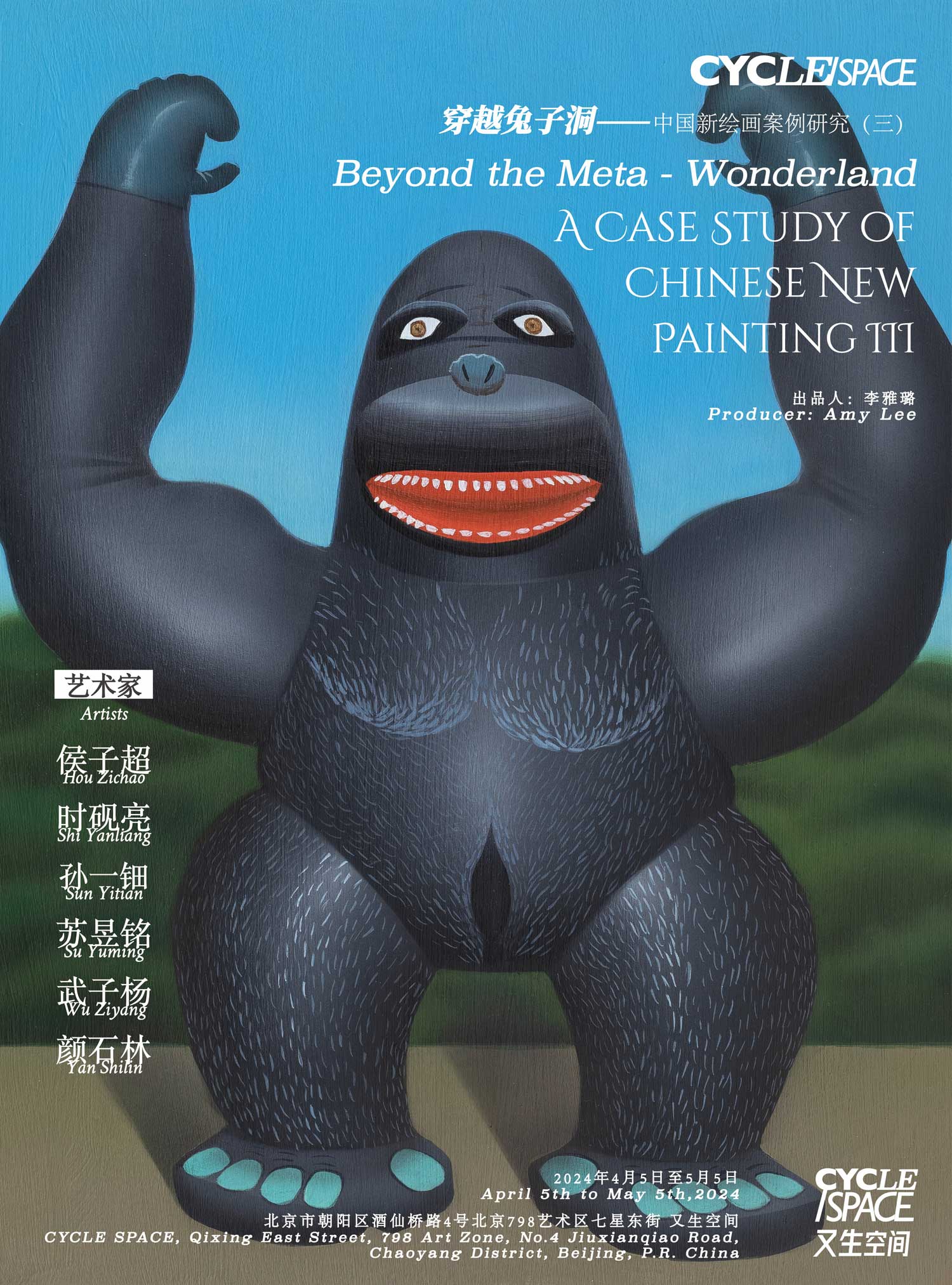展期 Period:
2024.4.5—2024.5.5
艺术家 Artist:
侯子超 Hou Zichao、时砚亮 Shi Yanliang、孙一钿 Sun Yitian、苏昱铭 Su Yuming、武子杨 Wu Ziyang、颜石林 Yan Shilin
出品人 Producer:
李雅璐 Amy Lee
地点 Venue:
前言 Preface:
这个兔子洞很奇怪。爱丽丝往下掉得很慢,来得及看看四周。下面很暗,她什么也看不清。但她看到洞壁上有小柜子、书和画儿。
——爱丽丝漫游奇境记
《爱丽丝梦游仙境》讲述了一个名叫爱丽丝的小女孩为了追逐一只揣着怀表、会说话的兔子而不慎掉入了兔子洞,从而卷入了一场冒险的故事,简单且奇幻、轻松却神秘的情节赋予了它无尽的魅力。故事中“兔子洞”则在超百种语言的传播下成为了穿越现实、走向“奇观”的共识代表意象。
本次展览《穿越兔子洞——中国新绘画案例研究(三)》以“穿越兔子洞”比喻当代青年艺术家在题材选择、画面创造和成长路径上在“虚”与“实”之间穿梭的相似时代现象,延续以往的案例研究形式,选取艺术家侯⼦超、时砚亮、孙⼀钿、苏昱铭、武⼦杨、颜⽯林的9件作品,在实证之上展开绚丽梦境。
如果说案例研究(一)是艺术家们亲历的青春乐园,案例研究(二)是艺术家们理想架构的理性秩序,那么案例研究(三)则是“Z世代”艺术家亦实亦幻、不知真假、介于亲历与理想间的时代赋予的穿越机遇。他们青春期伴随着“人造物”“显像管”“电子屏”的集中爆发,成人后“元宇宙”从镜像孪生转向虚实共生,仿佛兔子的怀表以成年为界限,直接将他们带入数字灵境、赛博空间。
在此之前,艺术家学习古典,遵照现实,在此之后,一切失重,标准不再。如福柯所言:“讨论完整的历史,需要描述诸种空间,因为空间同时又是各种权力的历史。这种描述从地理政治的大策略到居住地的小战术”。所以这些艺术家进入以个人经验为题的“异托邦”(heterotopia),有的艺术家取材虚拟界面,转化为实的画面,例如苏昱铭画面背景受手机屏幕上的故障性频闪启发;侯⼦超选取矢量化的原始图腾印章作为视觉焦点;有的艺术家从采汲虚的工具性,实现作品之实,例如颜石林利用虚拟现实技术辅助具象雕塑创作;时砚亮的艺术实践则是基于计算机数码图式和传统绘画技法的融合而展开;有的艺术家以生命为实、作品主角对照为虚,例如孙⼀钿以塑料充气玩具为灵感来源,武⼦杨直接化用了科技生命,构建AI的“我”。
进入“兔子洞”是艺术家们被时代浪潮席卷后不可避免的趋向,但走出“兔子洞”,甚至是在“兔子洞”中穿梭自如,则是艺术家们能够在如海的青年艺术家群中脱颖而出的行动结果。如何走出?爱丽丝的解法是帮助兔子解决问题。福柯的解法是当乌托邦的危机解除或消除异托邦的偏移。那么,翻译在艺术语言中,不同艺术家给了不同的解法:侯⼦超选择虚焦弱化冲突;时砚亮则扭转日常扭转时间;孙⼀钿以双联画的形式为猩猩出走提供了空间;苏昱铭将错位情感共时;武⼦杨构造出他者替代性完成使命;颜石林则借助工具重塑灵境。
只有能够自由穿梭在失重、异化、冲突的当代话语矛盾中的艺术家,才能够在爱丽丝的游戏中胜出,否则迷失的不只是观众的眼球,更是艺术家自己的“重心”。
It was a very strange hole Alice was falling very slowly, and she had time to think and to look around her. She could see nothing below her because it was so dark. But when she looked at the sides of the hole, she could see cupboards and books and pictures on the walls.
—— Alice’s Adventures in Wonderland
Alice's Adventures in Wonderland tells the tale of a little girl named Alice who, in pursuit of a talking rabbit with a pocket watch, accidentally falls into a looking-glass and embarks on an adventure. Its simple yet fantastical and mysterious plot has endowed it with endless charm. The “rabbit hole" in the story has become a universally recognized symbol for traversing reality and entering a "marvelous" world through its dissemination in over a hundred languages.
The exhibition Beyond the Meta - Wonderland:A Case Study of Chinese New Painting III employs the metaphor of "through the rabbit hole" to illustrate how contemporary young artists navigate between the "virtual" and the "real" in their choice of subjects, creation of imagery, and growth paths. Echoing the similar era phenomenon of sharing the metaverse space, this exhibition continues the format of previous case studies, selecting nine works by artists Hou Zichao, Shi Yanliang, SunYitian, Su Yuming, Wu Ziyang, and Yan Shilin. It unfolds a splendid dreamscape grounded in empirical evidence.
If Youth Paradise - A Case Study of Chinese New Painting I was about the youthful paradise experienced by the artists themselves, and Order - A Case Study of Chinese New Painting II was about the rational order ideally constructed by the artists, then Beyond the Meta - Wonderland:A Case Study of Chinese New Painting III represents the opportunities for traversal granted by the era to the "Z Generation" artists, who exist in a realm that is both real and illusory, unknown as to whether it is true or false, situated between personal experience and ideals. Their adolescence coincided with the explosion of "man-made objects," "cathode ray tubes," and "electronic screens," and as adults, the "metaverse" has shifted from a mirrored twin to a coexistence of the virtual and the real. It seems as if the rabbit's pocket watch marks the boundary of adulthood, directly bringing them into the digital realm and cyberspace.
Prior to this, artists studied the classics and adhered to reality. Afterward, everything lost its gravity, and standards no longer existed. As Foucault stated, "To discuss the entire history requires the description of spaces, because spaces are also the history of various powers. This description ranges from geopolitical strategies to the small tactics of habitation." Therefore, these artists have entered into "heterotopias" themed on personal experience. Some artists draw from virtual interfaces and transform them into tangible images, such as Su Yuming, whose background paintings are inspired by the faulty flickering on a mobile phone screen. Hou Zichao selects vectorized original totem stamps as the focal point of his visuals. Some artists adopt the instrumental nature of the virtual to achieve the tangibility of their works, such as Yan Shilin, who utilizes virtual reality technology to assist in the creation of figurative sculptures. Shi Yanliang's artistic practice is based on the fusion of computer digital patterns and traditional painting techniques. Some artists regard life as real and the protagonist of their works as illusory, such as Sun Yitian, who uses plastic inflatable toys as a realistic source. The realistic exterior and hollow interior of these toys provide her with a wormhole to the past. Wu Ziyang directly incorporates technological life to construct an AI "self."
Entering the “rabbit hole" is an inevitable trend for artists who have been swept up by the tides of the times. However, exiting the “rabbit hole" or even freely navigating within it is the result of actions that allow artists to stand out from the sea of young artists. How to exit? Alice's solution was to help the rabbit solve its problems. Foucault's solution is to resolve the crisis of utopia or eliminate the deviation of heterotopia. In the language of translation in art, different artists provide different solutions: Hou Zichao chooses to weaken conflicts through defocusing; Shi Yanliang twists the ordinary and reverses time; Sun Yitian provides space for the chimpanzee's escape through a double-panel painting; Su Yuming synchronizes misplaced emotions; Wu Ziyang constructs an alternative "other" to fulfill the mission; and Yan Shilin uses tools to reshape the spiritual realm.
Only artists who can freely navigate the contradictions of contemporary discourse, such as weightlessness, alienation, and conflict, can emerge victorious in Alice's wonderland. Otherwise, it is not just the audience's gaze that will be lost, but more importantly, the essence and meaning of their artistic creation.

